Lemon Pound Cake Recipe
If you love lemon, you’ve gotta try this lemon pound cake recipe! Just bursting with tangy lemon flavor and so moist! Made with all butter, for a velvety texture that practically melts in your mouth.
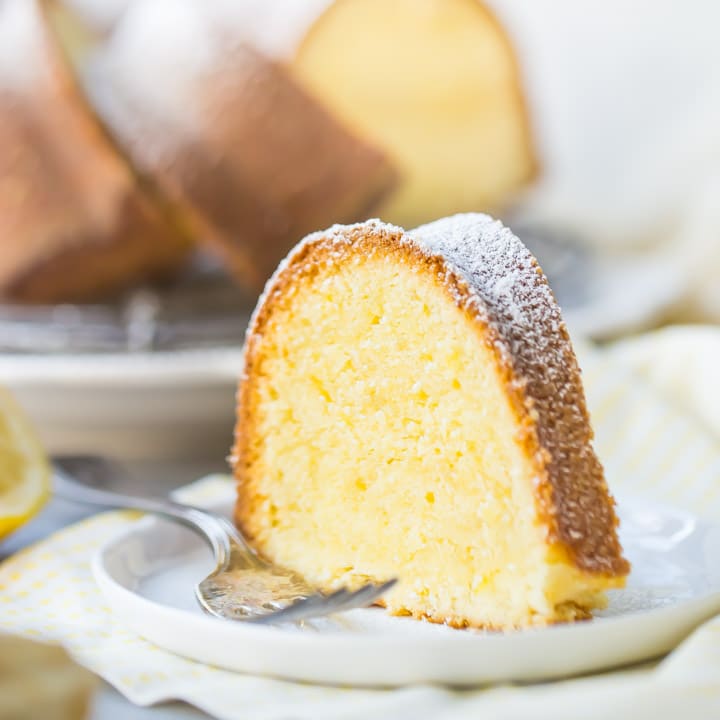
Original publish date: March 20, 2018.
Spring cannot come soon enough for me!
I’m craving bright, sunny flavors to get me through these last few weeks of bitter cold! This lemon pound cake is just what the doctor ordered.
When I set out to make a lemon pound cake recipe, I’ve got a few things in mind. Namely, it should be:
- Moist.
- Buttery.
- Lemon-y!
That last one is a biggie! Nothing bugs me more than a dessert that lacks flavor.
Not an issue here, my friend. This lemon pound cake recipe is made with the zest and juice of two whole lemons! Plus there’s a little lemon extract in there too, just for good measure.
There’s no mistaking that this is a lemon pound cake. So bright, tangy, and sunshine-y!
And the “moist” and “buttery” are covered, too. It’s made with all butter, which makes the recipe simple and straightforward, and makes the final cake so moist and velvety!
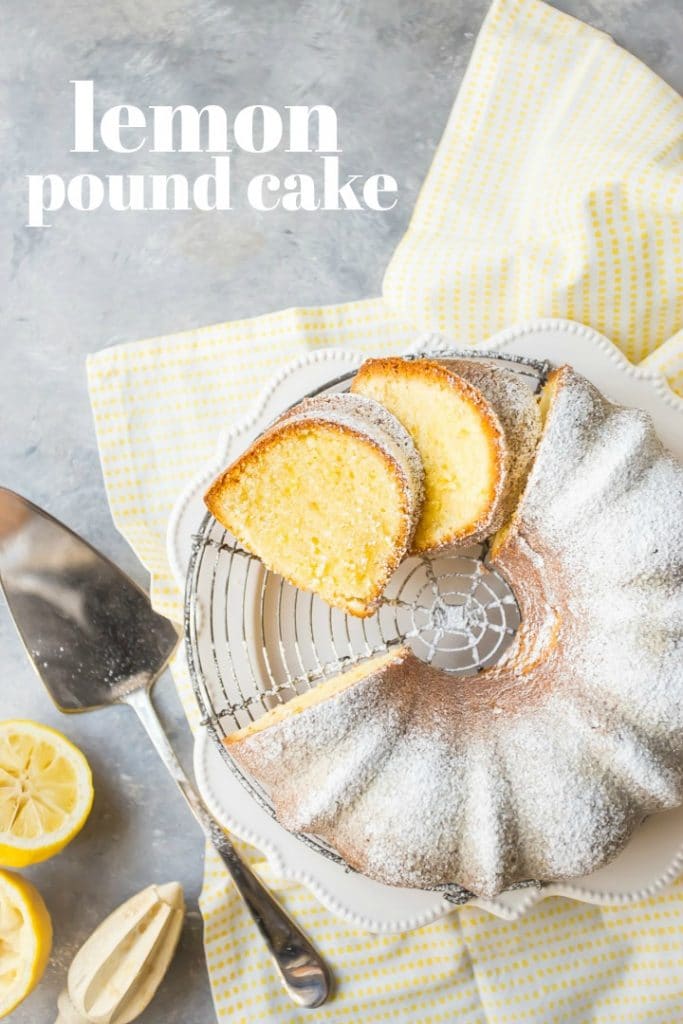
Table of Contents
- What is lemon pound cake?
- Why this is the best lemon pound cake recipe
- Ingredients
- Tools
- How to make lemon pound cake
- How to serve
- Expert tips
- FAQS
- A few more of my best lemon recipes
What is lemon pound cake?
Lemon pound cake is a dense, moist cake typically made with butter, sugar, eggs, flour, and lemon zest or lemon extract.
The traditional recipe calls for a pound of each of these main ingredients: butter, sugar, eggs, and flour.
The lemon flavor comes from the addition of lemon zest, lemon juice, and lemon extract, giving the cake a bright, citrusy taste.
Why this is the best lemon pound cake recipe
- Flavorful: This recipe boasts a prominent lemon flavor that comes from fresh lemon zest, lemon juice, and lemon extract. You’ll taste the lemon in every bite!
- Simple: The use of simple, wholesome ingredients like butter, sugar, eggs, flour, and lemons, makes it easy to prepare and accessible to all bakers.
- Easy: This recipe requires no advanced baking skills. It’s perfect for a novice baker!
- Versatile: This recipe is highly customizable, allowing you to use it as a base and really get creative with add-ins and adornments!.
Ingredients
Butter: Provides richness and flavor to the cake, and keeps it meltingly moist. I like unsalted butter best because it allows you to control the amount of salt. Different brands can have different amounts of salt, so this way you get a consistent result. For a vegan or dairy-free lemon pound cake recipe, use a plant-based butter that can substitute for dairy butter 1:1. This recipe works best if you allow the butter to come to room temperature first. You can set it out on the counter a few hours ahead of time, or you can microwave it for 10 seconds, turn it over, and microwave it again for another 8 seconds.
Sugar: Granulated white sugar sweetens the cake but also contributes to its texture, tenderness, and browning when baked.
Eggs: Act as a leavening agent, helping the cake rise and providing structure. Eggs also contribute to the cake’s richness and moisture. Use large, whole chicken eggs, preferably at room temperature (although I don’t find this to be critical), or a plant-based 1:1 substitute.
Flour: I like cake flour in this recipe. Cake flour has a lower protein content so it gives you a more tender, delicate crumb. If you’re unfamiliar with this product, click here: What is Cake Flour? For gluten-free lemon pound cake, swap in a cup-for-cup gluten-free flour blend.
Lemon: Lemon juice and zest provide the cake with its distinctive lemon flavor. The juice adds acidity, which reacts with the leavening agents to help the cake rise, while the zest contains aromatic oils that intensify the lemon flavor. I also like to add in a splash of lemon extract to bring that flavor out even more.
Salt: I like kosher salt best because it’s cheap, easy to source, and doesn’t have any bitter-tasting additives like iodine.
Tools
- Measuring cups and spoons: Follow my guide on how to measure ingredients.
- Bowl: A large mixing bowl, for mixing up the batter.
- Mixer: Either a stand mixer fitted with the paddle attachment, or a hand-held electric mixer.
- Silicone spatula: For scraping the bottom and sides of the bowl, folding in the dry ingredients, and for getting every last bit of batter out!
- Microplane: To remove the zest from the lemons.
- Juicer or reamer: For juicing the lemons.
- Pan: A 12-cup capacity bundt pan.
- Non-stick spray: For greasing the pan.
- Skewer: For testing if the cake is done baking.
- Wire rack: For cooling.
How to make lemon pound cake
This easy recipe comes together in 4 simple steps.
Step 1: Cream the butter and sugar
Place the soft butter and sugar together in your mixing bowl and whip them up until they’re very pale and fluffy.
This typically takes no less than 5 full minutes, and you don’t want to skimp because this step incorporates a lot of air and will make your cake nice and light. I set a timer!
Step 2: Add liquids
Scrape down the bottom and sides of the bowl to incorporate any stiff butter that may be clinging, then start adding the liquids.
Crack the eggs in one at a time, and stir each one in fully before adding the next. This will help avoid lumps.
The lemon zest, juice, and extract can also go in at this stage.
Step 3: Fold in dry ingredients
Add in the flour and salt, mixing in gently until just barely incorporated.
Step 4: Bake
Transfer the batter to your greased and floured cake pan, and bake it until it’s puffed and springy.
You’ll know it’s done baking when a skewer inserted in the thickest part comes out clean or with a few crumbs.
How to serve
This lovely cake can be enjoyed for dessert or as an afternoon pick-me-up. It’s really nice with a cup of coffee or tea!
I like it at room temperature but it’s also really good warm or chilled.
I’ve garnished this cake with a dusting of powdered sugar, but there are countless other ways to enjoy it:
- Whipped cream: Serve slices topped with a dollop of whipped cream.
- Fresh berries: Top slices of lemon pound cake with fresh berries such as strawberries, blueberries, or raspberries.
- Lemon glaze: Drizzle a lemon glaze (made by stirring lemon juice into powdered sugar) over the top of the cake for extra lemon flavor and a glossy finish.
- Lemon curd: A spoonful of lemon curd or homemade jam really brings something special!
- Ice cream: Top the cake with a scoop or two of ice cream or sorbet.
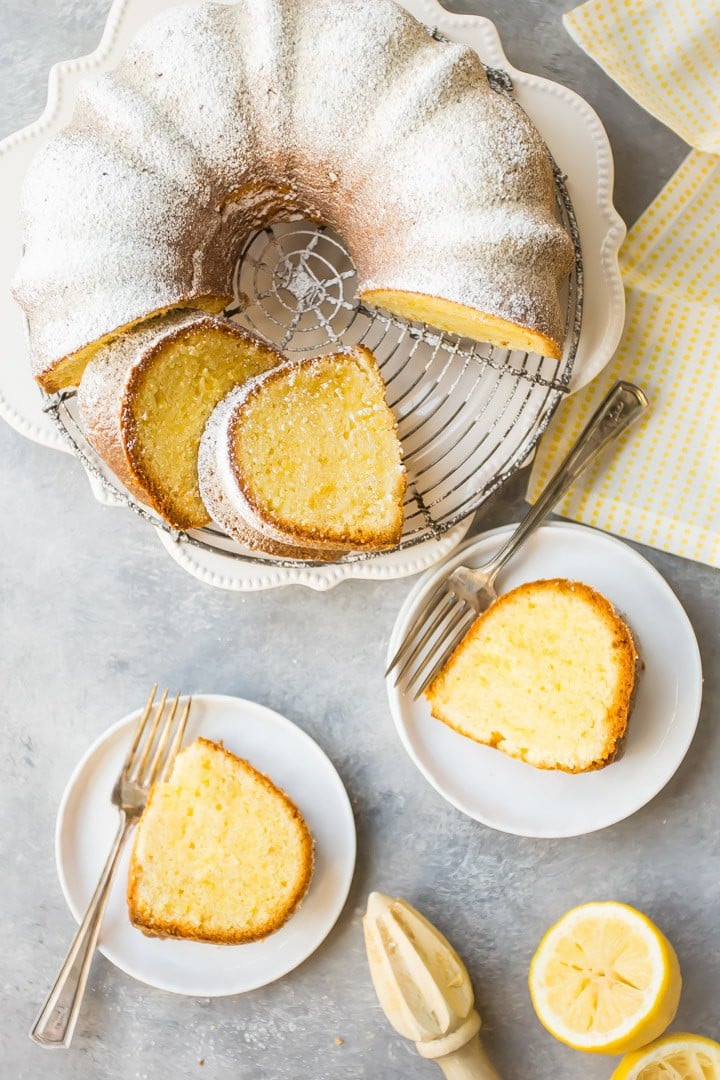
Expert tips
Get creative: Feel free to adjust this recipe to suit your own personal taste. Try folding in poppy seeds or berries, or a unique spice such as ginger or cardamom. The sky’s the limit!
Whip in lots of air: It’s really important to whip a lot of air into the butter and sugar mixture. This will really help your cake to rise and have a light, airy texture. I set a timer and give it no less than 5 full minutes on medium-high speed.
Don’t overmix: Once the flour’s gone in, be careful not to overwork the batter. This could activate the natural glutens and result in toughness. Give it the fewest possible number of strokes to get things combined.
Keep an eye: Flip on the oven light and peek in on your cake as it’s baking. Once the center no longer looks wet, crack the door and give it a feel. If it’s springy, slip in a skewer. If it comes out clean, the cake is done! Be careful not to overbake it or it could come out dry.
Cool completely: Once it’s cool enough to handle, flip the lemon bundt cake out onto a wire rack to finish cooling.
FAQS
Pound cakes traditionally contain equal parts (by weight) of four main ingredients: flour, sugar, butter, and eggs.
Pound cakes have a dense and moist texture, with a tight crumb, while regular cakes can vary in texture depending on the recipe.
Pound cake is made with a delicate balance of ingredients, and if the ratio of flour, sugar, butter, and eggs is off, the cake can turn out dry.
The same can be true if they are baked for too long or at too high a temperature.
It’s important to measure accurately and follow sensory cues to check for doneness, rather than just relying on the times given (which are only meant as a rough guideline).
And don’t forget about carry-over cooking! This is the idea that foods will continue to increase in temperature for several minutes after they’ve been removed from the heat source. If you bake the cake even a minute or two too long it could come out dry.
This lemon pound cake is perfect for making ahead.
It’s big and it can really serve a crowd! So it’s nice to get a head start with recipes like this if you’re entertaining.
Keep your lemon pound cake at room temperature (lightly covered or under a dome so it doesn’t dry out) for several days.
Or chill it in the fridge (tightly covered) for a week or so.
It will also freeze very well, and should last in the freezer for at least a month or two. Thaw in the fridge or at room temperature.
This cake can serve 16 people easily.
The nutritional info below is for 1/16th of the cake, and it includes the powdered sugar garnish.
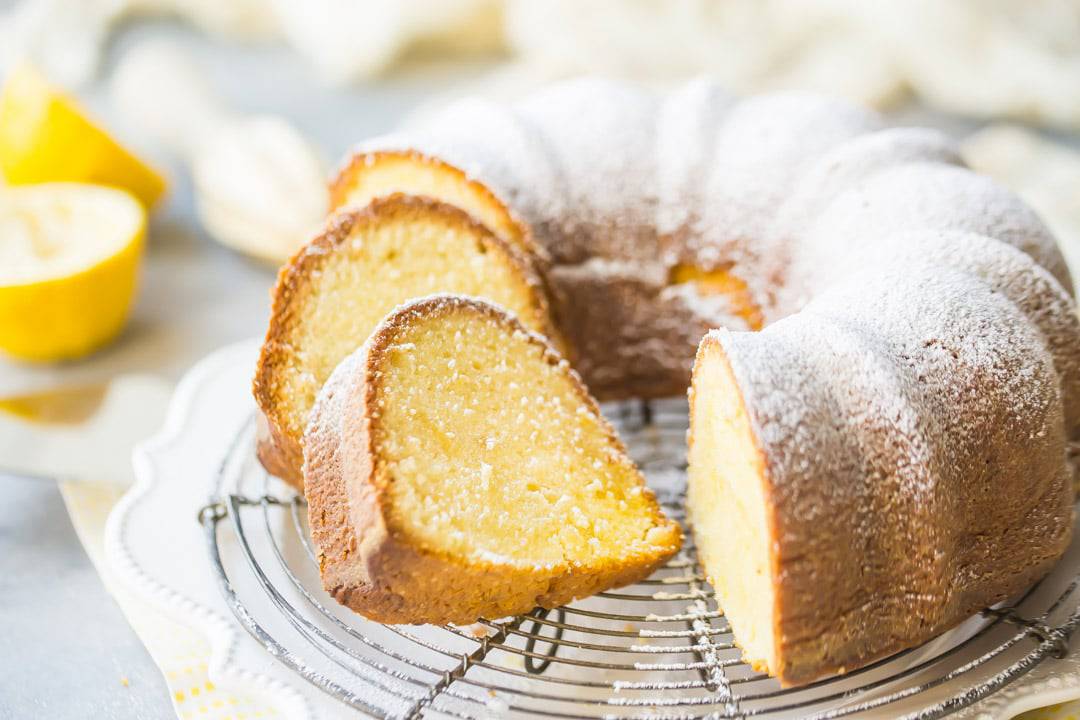
A few more of my best lemon recipes
This post contains affiliate sales links.

Lemon Pound Cake Recipe
Ingredients
- 2 1/2 cups (567.5 g) unsalted butter, softened
- 3 cups (600 g) granulated sugar
- 6 (264 g) eggs, large
- 2 teaspoons (10 g) lemon extract
- 1/4 cup (61 g) lemon juice , (from about 2 lemons)
- 2 tablespoons (12 g) lemon zest, (from about 1 lemon)
- 3 cups (375 g) cake flour
- 2 teaspoons (12 g) kosher salt
- 1 tablespoon (8 g) powdered sugar, (optional garnish)
Instructions
- Preheat the oven to 350 degrees F, generously mist a 12-cup bundt pan with non-stick spray, and dust with flour.
- In a large bowl with an electric mixer, cream the butter and sugar together on medium-high speed until pale and fluffy (at least 5 full minutes).
- Scrape the bottom and sides of the mixing bowl with a silicone spatula, then beat in the eggs, one at a time, allowing each one to become fully incorporated before adding the next.
- Scrape the bottom and sides of the mixing bowl with a silicone spatula, then add the lemon extract, lemon zest, and lemon juice, mixing on medium speed until smooth.
- Add the flour and salt, mixing on medium speed until just barely incorporated.
- Transfer the batter to the prepared pan, and bake until puffed and springy in the center (approx. 75 to 85 minutes). A bamboo skewer inserted in the thickest part of the cake should come out clean or with a few moist crumbs.
- Cool in the pan for 30 minutes, then invert onto a wire rack to cool completely.
- Dust with powdered sugar for garnish.











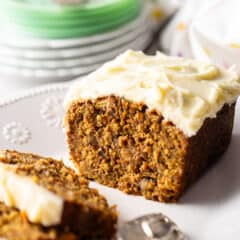
Can this lemon pound cake be made with gluten free flour?
I have not tested it that way so I can’t say for sure, but I think it’s worth a try. Be sure to use a blend that swaps 1:1 for regular flour. Good luck and I hope you enjoy!
2-1/2 CUPS of butter to 3 cups of flour?? That has to be a typo. Are you sure it shouldn’t be 2-1/2 STICKS of butter, which is 1-1/4 cups? I was all set to make this but I don’t dare.
I’m quite sure. It’s a pound cake & that ratio is typical for pound cake. Do a quick google search & see for yourself. Also if you take a minute to read the comments before you you’ll see that several other readers have made it & been very happy with the outcome.
Super moist and absolutely delicious. Very lemony which I like. The only negative is that the exterior was too dark. I made half the recipe, adjusted for pan size, and cooked at 350 for an hour. I checked at 50 mins, still raw, at an hour it was perfect. So I honestly think it just browns too quickly. Do you think an hour at 325 would be better? Thanks!
Hey Jade! I think it might for you. It could have something to do with your oven or it may have to do with the pan you used. Darker pans tend to absorb more heat, so if you use a lighter-colored pan that could make a difference as well.
When I do not have cake flour, here is a great substitute. For each cup of flour, I put one tablespoon of corn starch ( corn flour) in the bottom of the measuring cup and add sifted flour to fill the cup. Works beautifully.
Thanks for the great tip!
I made this cake for a Anniversary Dinner and it was amazing. It was rich lemony and moist. I made a strawberry buttercream icing and put chocolate covered strawberries on top. My family and friends was hooked on the first bite and couldn’t stop eating it until it was all gone. This one is definitely a hit and keeper.
That sounds fantastic! Love how you made it your own. And so glad everyone loved it!
Only thing I can say is simply delicious followed the directions and whew child 5-stars
So happy you liked it! Thank you for the positive feedback!
So glad to hear it! Thank you so much!
What if I wanted to tweak the measurements for a 9×5 loaf
Pan
You would just want to halve it in that case. And be sure to adjust the bake time. You’ll know it’s done when a toothpick inserted in the thickest part comes out clean.
First time in several hundred cakes that a recipe totally failed. Cake wouldn‘t come out of the form, was burned on top and still uncooked inside, although I followed the recipe closely.
Looks to me like there is too much butter – have never seen that much butter in a cake. Could it be that there is spelling error and the right quantity would be 1 1/2 cups??
Sorry to hear you had trouble. The amounts stated are correct- it’s a large cake (serves 16-20; 10 baked in a 10-cup pan), and it’s a pound cake so the ratios are standard for this type of cake. I’ve made it successfully numerous times, one of which was on camera and can be viewed on this post. There are also a lot of comments from other bakers here who have had success with the recipe as written. It can be tricky to get out of the pan, so you really need to grease it well and flour it generously. If it is browning too quickly, it may be because your oven runs a little hot (this is not uncommon). You might want to lower the temperature to compensate for that, and extend the bake time as needed.
Great cake. I got a mixer and did this as my first time baking…. It turned out amazing. So moist, and tastes amazing. Great recipe. The only issue I had was my oven is apparently not even. When rising, it weren’t over on one side a bit.
Congrats on your new mixer! So happy the recipe worked well for you, even if you did lose a little over the side of the pan, lol!
I’ve made this cake 2x in last month. Love it, but every time it starts to to burn last 20 min. I’ve been making pound cakes for over 30 years, but I’m stumped. Any thoughts.
So happy you like the cake Tiffany! I’m wondering if it might have something to do with the pan you’re using? Just because I happened to be baking mini-muffins over the weekend. I have 3 different mini-muffin pans, and I notice that even though they’re all filled with the same batter and baked on the same oven rack at the same temperature for the same amount of time, some of them bake up really brown and some come out pale. Even though they’re all the same done-ness on the inside! Have you tried using another bundt pan? I wonder if you might have different results. Another possibility could be that your oven just runs a bit hot. You can buy one of those little oven thermometers for just a few dollars, and hook it on one of the racks to see if the temp is accurate. If not, just adjust accordingly. It’s amazing how far ovens can wander out of calibration over time!
I made this recipe, and followed it to the letter, yesterday, adding a couple of tips that I found from another website about how to get a pound cake with a truly fine crumb. I made sure that not only was my butter absolutely room temperature, but my eggs and lemons were as well. I submerged the eggs in warm water for about 10 minutes to make sure since the house was a bit chilly. I creamed the butter for about 2 minutes before adding the sugar in, and then creamed the butter and sugar for a full 8 minutes, stopping twice to scrap the bowl. Once the butter/sugar was incredibly fluffy, I made sure to incorporate the eggs slowly, just like the recipe states. I couldn’t believe how pretty and fluffy it all looked! I decided to use Swan’s Cake Flour instead of all purpose flour. I was rewarded with the fluffiest pound cake batter I think I have ever seen!
The cooking times are spot on in this recipe…and when it was done. Oh my goodness. THIS is the pound cake of your dreams! It was just absolutely perfect. Moist and dense the way a pound cake should be…but with the most incredible light, fine crumbed texture you can imagine. My family of eight loved it…and true to your word, we each had a slice after dinner, with just the right amount to each have another slice for breakfast.
I did add a glaze to the top of mine. I wanted to mimic the glaze thickness and texture of Starbuck’s Lemon Loaf. Do I used 3 cups of confectioner sugar, about 2-3 tbsp of fresh lemon juice, 2 tbsp of heavy cream and 2 drops of lemon extract. It was more than enough to produce a very creamy glaze that flowed down the cake just the right amount.
I absolutely love your comment KB! So thrilled to hear that this recipe was such a smashing success for you. Thank you so much for the 5-star rating, and for sharing your glaze recipe! It sounds fantastic, I can’t wait to try making it that way.
The lemon pound cake receipe lists lemon juice two times in the ingrediants section, but mentions lemon zest in the instructions. Is this a typo? Should one of the items in theingrediants read “lemon zest”? If so, which one? 2 Tbsp?
Thanks for bringing it to my attention Sharon. It should have called for 2 tablespoons of zest, not juice. I have made the correction.
When baking in a loaf pan, I start checking the cake about the half way mark or about 40 minutes. I love to make this recipe in mini loaf pans and a 35 minute bake time is perfect. I give them away and people love this cake. I, also, use Baker’s Joy liberally in all my pans. I’ve never had a sticking problem.
Great to know! Thanks so much for sharing Kellie!